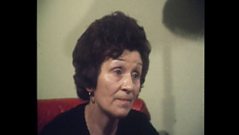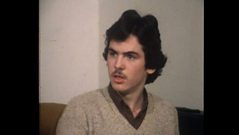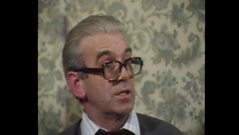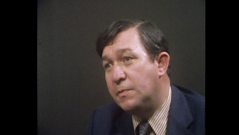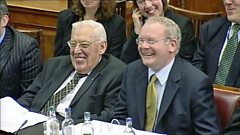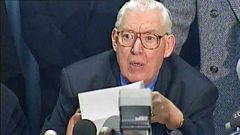
Flaws in forensic evidence
Forensic tests used to convict Giuseppe Conlon (and other members of the Maguire Seven) for the 1974 Guildford and Woolwich pub bombings are found to be unsound.
In March 1976 Giuseppe Conlon was sentenced to 12 years in prison for possession of explosives.
Reporter Gavin Esler outlines the police’s case against Giuseppe: his son Gerry was a Provisional Irish Republican Army (PIRA) bomber, who had blown up pubs in Guildford and Woolwich; Gerry Conlon had named his aunt Anne Maguire as a source of the explosives used (Giuseppe was arrested in Anne Maguire’s home along with his co-accused, collectively known as the Maguire Seven); traces of nitro-glycerine had been found on his hands.
Elser goes on to state that the police did not find any explosives in the Maguire house or in the surrounding area.
He then describes the Thin Layer Chromatography (TLC) test used to establish the presence of nitro-glycerine on the hands of the accused. This test was developed by Dr. John Yallop, a forensic scientist and witness for the defence (Dr. Yallop did not wish to be interviewed for the programme).
Dr. Yallop’s test is repeated in a lab in Belfast. Yallop had discovered that at least one other substance could give the same result in the TLC test (a distinctive pink spot) as nitro-glycerine would give. Therefore the test could not prove the presence of nitro-glycerine.
Dr. James Grimshaw (of the Department of Chemistry at Queen’s University in Belfast) states that a single TLC test is not enough to establish the presence of nitro-glycerine. It is impossible to check the original test results as these were not photographed.
Alastair Logan, the Guildford solicitor who took up Giuseppe Conlon’s case on appeal, lists the weakness in the evidence against the Maguire Seven; for example, the scientist who carried out the forensic tests was an inexperienced 18 year-old.
CONTEXT
On 5 October 1974 the Provisional Irish Republican Army (PIRA) targeted Guildford, Surrey, because it was situated close to a number of garrison towns. The PIRA planted two six-pound gelignite bombs in two pubs. The first exploded just before 9.00pm in the Horse and Groom, destroying the front of the building and shattering the windows of neighbouring shops.
It killed Paul Craig, a plasterer (22 years old); two members of the Scots Guards, William Forsyth (18) and John Hunter (17); and two members of the Women’s Royal Army Corps, Caroline Jean Slater (18) and Ann Ray Hamilton (19). A further sixty-five persons were wounded.
After the first explosion, other public houses were evacuated, including the Seven Stars where the second bomb exploded at approximately 9.35 p.m. without causing any serious injuries.
On November 7 1974 Gunner Richard Dunne, a soldier (42) and Alan Horsley, a sales clerk (20) were killed when a PIRA bomb exploded in the King’s Arms in Woolwich. Twenty-six people, including five soldiers, were injured.
In December 1974 the police arrested three men and a woman: Gerry Conlon, Paul Hill, Patrick Armstrong and Carole Richardson. In October 1975 these four were convicted of the Guildford and Woolwich bombings and given life sentences. The group was known as the Guildford Four.
On 4 March 1976 the Maguire Seven were convicted of making the explosives used in these bombings. The Maguire Seven were: - Anne Maguire, Patrick Maguire (Anne’s husband), Patrick Maguire (son of Anne and Patrick), Vincent Maguire (son of Anne and Patrick), Sean Smyth (brother of Anne), Patrick O’Neill (family friend) and Giuseppe Conlon (brother-in-law of Anne Maguire and father of Gerry Conlon).
Over the years, the cases of the Guildford Four and the Maguire Seven came under increasing legal scrutiny and the range of those seeking a review of the convictions extended widely. On 17 October 1989 it was announced that corruption proceedings would be taken against the police involved in the conviction of the Guildford Four. Two days later, with the exception of Paul Hill, those convicted for the bombings were released. This followed an announcement by the Director of Public Prosecutions that it would be wrong for the Crown ‘to seek to sustain’ the convictions of 1975 on the basis of confessions that they had later retracted. The Court of Appeal had decided that the DPP in 1975 had suppressed scientific evidence which conflicted with the confessions. Paul Hill remained in custody because he was implicated in a case that had not yet been resolved. His conviction was eventually quashed in April 1994.
On 26 June 1991 the Court of Appeal overturned the sentences on the Maguire Seven. All of them had completed their sentences. Afterwards many criticised the court for dismissing most of the grounds of appeal and had simply concluded that the hands of the convicted could have been innocently contaminated with nitro-glycerine.
Duration:
This clip is from
More clips from Giuseppe Conlon and the Bomb Factory
-
![]()
PIRA bomb England
Duration: 04:08
-
![]()
Patrick Maguire recalls his arrest
Duration: 01:43
-
![]()
Giuseppe Conlon is arrested
Duration: 02:06
-
![]()
Giuseppe Conlon is an unlikely terrorist
Duration: 03:20
More clips from Spotlight
-
![]()
Hamza and Salam's escape—29/09/2015
Duration: 01:59
-
![]()
A Long Way from Clare to Here—29/09/2015
Duration: 02:25
-
![]()
Paisley and the Good Friday Agreement—Paisley and the Pretender
Duration: 02:13

